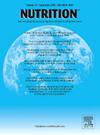High-protein diet based on whey protein isolate preserves muscle mass and its association with resistance training attenuates glomerular hypertrophy in rats
IF 3.2
3区 医学
Q2 NUTRITION & DIETETICS
引用次数: 0
Abstract
Objective
To evaluate the effect of administering a high-protein diet (HP) based on whey protein isolate (WPI) associated with ST in rats.
Methods
Twenty-two Wistar rats were fed a diet containing either 14% WPI (normoproteic) or 35% WPI (high protein) and were subjected to stair training or kept sedentary for 12 weeks. SN = sedentary normoproteic; SH = sedentary high protein; TN = trained normoproteic; TH = trained high protein.
Results
HP decreases food intake (P < 0.0001). The SH group showed a significant reduction in plasma triglycerides (P = 0.03). Quadriceps weight was greatest in TH, followed by SH and TN (P < 0.0001). Kidney weight was greater in TH, followed by SH and TN, and was greater than in SN (P < 0.0001). Urea levels were lowest in the SN group (P < 0.001). The urinary space was larger in the TH and SH groups. HP and ST increased the cross-sectional area (CSA) of the gastrocnemius (P < 0.0001) and quadriceps (P < 0.0001) muscles. Hepatic glycogen deposits were highest in the SH group (P < 0.0001).
Conclusions
HP with 35% whey promoted satiety and increased hepatic glycogen content without affecting glycemia. Its combination with ST was more efficient in increasing muscle hypertrophy, altering plasma urea levels, and enlarging the urinary space. These findings may be related to the adaptive process of renal physiology stimulated by HP.
以分离乳清蛋白为基础的高蛋白饮食可保持肌肉质量,其与抗阻训练的关联可减轻大鼠肾小球肥大
目的评价以分离乳清蛋白(whey protein isolate, WPI)为基础的高蛋白饮食(HP)对ST大鼠的影响。方法将22只Wistar大鼠分别饲喂含14% WPI(正常蛋白)或35% WPI(高蛋白)的日粮,进行楼梯训练或静坐12周。SN =久坐正常蛋白;SH =久坐高蛋白;TN =训练正常蛋白;TH =训练高蛋白质。结果shp可减少食物摄入量(P <;0.0001)。SH组血浆甘油三酯显著降低(P = 0.03)。股四头肌重量在TH时最大,其次是SH和TN (P <;0.0001)。肾重以TH组大,SH、TN次之,SN组大(P <;0.0001)。SN组尿素水平最低(P <;0.001)。TH和SH组尿腔较大。HP和ST增加腓肠肌的横截面积(CSA) (P <;0.0001)和股四头肌(P <;0.0001)的肌肉。肝糖原沉积以SH组最高(P <;0.0001)。结论35%乳清的shp可促进饱腹感,增加肝糖原含量,但不影响血糖。它与ST联合在增加肌肉肥大、改变血浆尿素水平和扩大尿空间方面更有效。这些发现可能与HP刺激肾脏生理适应过程有关。
本文章由计算机程序翻译,如有差异,请以英文原文为准。
求助全文
约1分钟内获得全文
求助全文
来源期刊

Nutrition
医学-营养学
CiteScore
7.80
自引率
2.30%
发文量
300
审稿时长
60 days
期刊介绍:
Nutrition has an open access mirror journal Nutrition: X, sharing the same aims and scope, editorial team, submission system and rigorous peer review.
Founded by Michael M. Meguid in the early 1980''s, Nutrition presents advances in nutrition research and science, informs its readers on new and advancing technologies and data in clinical nutrition practice, encourages the application of outcomes research and meta-analyses to problems in patient-related nutrition; and seeks to help clarify and set the research, policy and practice agenda for nutrition science to enhance human well-being in the years ahead.
 求助内容:
求助内容: 应助结果提醒方式:
应助结果提醒方式:


